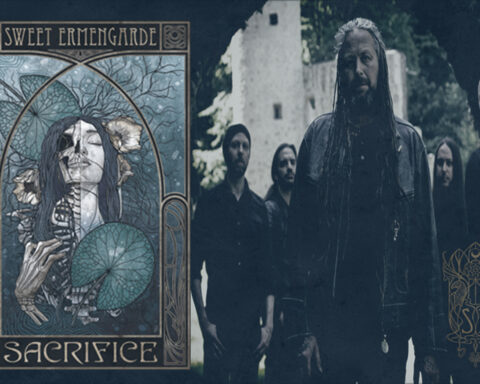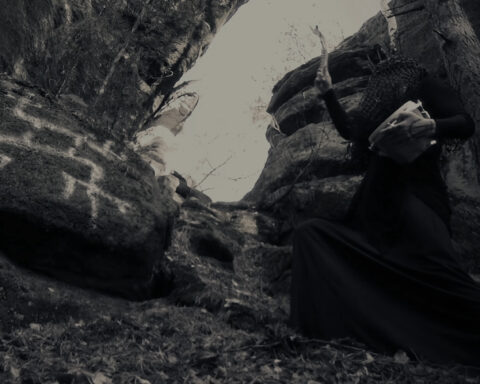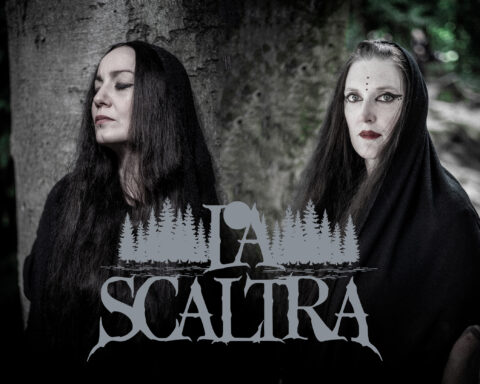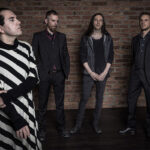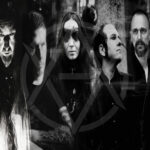[german version – english below]
Edie, du bist Autorin und Videokünstlerin. Das geschriebene Wort und das Visuelle – wo kommt deiner Meinung nach die Kunst/Kreativität stärker zum Ausdruck?
Schreiben und Videos drehen sind für mich zwar zwei unterschiedliche Ausdrucksmöglichkeiten, die aber sehr gut zusammenpassen. Beides beginnt mit visuellen Vorstellungen in meinem Kopf, die ich dann entweder zu Papier bringe oder nachstelle. Bei beiden geht es mir darum, Stimmungen zu erzeugen und Geschichten zu erzählen. Insofern kann ich gar nicht sagen wo die Kunst/ Kreativität stärker zum Ausdruck kommt. Schreiben hat den Vorteil, dass ich dafür keine anderen Menschen brauche und es keine Limitierungen gibt. Musikvideos haben den Vorteil, dass ich sie in enger Zusammenarbeit mit der jeweiligen Band mache und wenn zwei kreative Menschen sich Ideen hin- und herwerfen, kollidieren die manchmal und es entstehen wunderbare Ideenmonster, die man allein nie erschaffen hätte.
Wie kam es dazu, dass du dich neben dem Autorinnendasein auch zur Videokünstlerin entwickelt hast?
Lustigerweise war es bei mir genau andersherum. Ich habe immer schon gerne geschrieben, habe das Schreiben aber nie ernst genommen und für ein paar Jahre regelrecht vergessen. Neben dem Studium (Kommunikationswissenschaften und Digitale Kunst) habe ich damals bei einem Fernsehsender gearbeitet, Filmen und Schneiden gelernt und eigene Beiträge produziert. Von dem ausgehend kam ich dann zu Musikvideos, die mir mehr Freiheiten boten als Fernsehbeiträge. Zur Autorin wurde ich erst 2012, als ich „versehentlich“ mein erstes Buch „3 a.m.“ geschrieben habe. Ich habe einfach angefangen zu schreiben und monatelang nicht aufgehört. Interessanterweise hat das mein näheres Umfeld weniger überrascht als mich selbst.
Du hast in den vergangenen Jahren äußerst produktiv für The Devil & The Universe als auch für Whispers in the Shadow Videos gedreht und geschnitten. Sehr verschiedene Musikstile und komplett verschiedene Botschaften der jeweiligen Musiker. Was ist für dich als Erstes ausschlaggebend für Ideen, wenn ein Videodreh ansteht: der jeweilige Song (musikalisch) oder die Botschaft, die visuell vermittelt werden soll?
Für mich steht der Song im Mittelpunkt, den ich mir immer und immer wieder anhöre. Währenddessen beobachte ich die Bilder, die sich zu dem Sound in meinem Kopf formen. Die sortiere ich dann so lange aus, bis brauchbare Bilder entstehen, die ich auch mit den mir zur Verfügung stehenden Mitteln umsetzen kann. Wenn ich zu einem Song sehe, wie die Band durch die Wüste läuft, ist das zwar in meiner Vorstellung unterhaltsam, aber ich glaube kaum, dass ich die fünf Männer von Whispers in the Shadow einpacken und in die Sahara fliegen kann. Wobei ich sie das ehrlich gesagt noch nicht gefragt habe. Die Botschaft, die die Band vermitteln will, ist da meistens schon irgendwie mit drin, weil ich schon beim Auswählen des Songs mit ihnen darüber rede, wovon der Song und das jeweilige Album handeln und mir das als Inspiration dient.
Spielt dein persönlicher Musikgeschmack für den Videodreh eine bedeutende Rolle? Immerhin musst du dir beim Videoschnitt das Ganze unzählige Male anhören!
Ja, definitiv. Ich drehe kein Video zu einem Song, den ich nicht mag oder der mir auf die Nerven geht. Da achte ich schon auf meine psychische Gesundheit. Außerdem würden mir wahrscheinlich nur veraschende, ironische Ideen zu solchen Songs kommen und das ist ja auch nicht Sinn und Zweck der Sache.
Gab es mal ein Anfrage für einen Videodreh, den du abgelehnt hast?
Es gab einen Song von The Devil & The Universe, den ich abgelehnt habe. Ich sage nicht welchen, aber er ist auf dem Album „Benedicere“. Ansonsten haben mich schon hin und wieder Bands gefragt, ob ich für sie ein Video mache, aber es scheitert dann in der Regel an den Freiheiten, die ich einfordere, weil das sehr viel Vertrauen voraussetzt.
Was ist wichtiger für einen erfolgreichen Videodreh: Spontanität und Improvisationstalent oder eine strikte Planung und Vorbereitung bis ins kleinste Detail?
Allgemein kann ich die Frage nicht beantworten, ich denke es sind auf beide Arten sehr erfolgreiche und grandiose Videos entstanden. Ich persönlich brauche eine Mischung aus beidem. Es gab für jedes meiner Videos einen groben Plan und eine spezielle Grundidee. Sei es der Schnitt, der Stil oder die Story, die erzählt werden soll. Am Set herrscht dann aber kreatives Improvisationschaos, in dem meistens die besten Szenen entstehen. Da wird der Plan dann schnell mal über den Haufen geworfen, wenn durch die Kameralinse etwas anderes viel besser aussieht als zu Hause auf dem Sofa erdacht. Ich werfe mich da auch gerne körperlich rein, halte mit einer Hand den Scheinwerfer, mit der anderen die Kamera und gib Anweisungen. In so einer Atmosphäre fühle ich mich wesentlich wohler als mit striktem Drehplan. Außerdem bin ich eine große Freundin von Zufällen und Fehlern, auch beim Schnitt. Bei „Kali’s Tongue“ war es ursprünglich zum Beispiel nicht beabsichtigt, dass der Himmel am Ende rot gefärbt ist. Ich habe einen Effekt ausprobiert, der etwas komplett anderes gemacht hat, als ich wollte und plötzlich war der Himmel so genial rot. Über so was freue ich mich immer besonders.
Wünsche-Zeit: keine Budget- , Zeit – oder Ortsgrenzen für einen Videodreh. Welche Settings, Equipments, Wünsche hättest du an dieser Stelle und für welche Art von Musik/Band?
Hach, da beginne ich ja gleich zu träumen. Wenn Geld keine Rolle spielen würde, hätte ich da schon einige Ideen, die große Studios oder Reisen nach Irland, England oder Island beinhalten würden. Was das Equipment betrifft, gibt es natürlich auch noch viel Luft nach oben. Ich arbeite nicht mit High-End-Geräten, wobei mir das auch eine gewisse Freiheit gibt. Ich weiß, was mit meinem Zeug geht und was nicht und was ich kann und was nicht. Dadurch kann ich mich beim Dreh auf andere Sachen als die Technik konzentrieren. Bezüglich Musik/ Band könnte ich mir gut vorstellen mit The Flaming Lips oder The KLF zu arbeiten. Auf jeden Fall eher abgefahrene Bands in deren Schaffen Humor einen ebenso großen Platz einnimmt wie in meinem. Und ich würde gerne mal Live-Schnitt für die Leinwände auf einem großen Festival machen. Vielleicht für Editors oder The Cure?
Viele Videokünstler haben eine „eigene Handschrift“ bei der visuellen Umsetzung. Würdest du für dich sagen, dass sich dies im Laufe der Zeit entwickelt oder ist diese „eigene Handschrift“ von Anfang da?
Ich schätze mal der eigene Stil entwickelt sich mit der Zeit. Natürlich ist es schon cool, wenn man z.B. bei Floria Sigismondi (Anmerk. der Red.: italienisch-kanadische Fotografin und Regisseurin) oder Anton Corbijn gleich erkennt, dass es sich um ihre Arbeiten handelt. Ich persönlich strebe aber nicht nach einem eigenen Stil. Ich finde Stringenz im kreativen Schaffen sogar absolut überbewertet und limitierend. Wer weiß, vielleicht drehe ich mal ein Schlager-Video oder schreibe ein Kochbuch. Ich kann’s mir zwar nicht vorstellen, würde aber nichts ausschließen, nur weil es gegenwärtig nicht in mein Bild von mir selbst passt.
Die Fans von Musikbands sehen in der Regel „nur“ das Endprodukt, sehr selten geben Bands Einblick in die Entstehung des Videos oder bieten gar Outtakes an. Hättest du sofort ein Video von TDATU oder WITS parat, bei denen Outtakes absolut das „Licht der Welt“ erblicken sollten? Oder ist dies für eine Videokünstlerin eher unüblich, wenn zum eigentlichen Video derartiges Material an die Öffentlichkeit kommt?
Beim Dreh konzentriere ich mich nur auf das Video, das entsteht und ein großer Prozentsatz des gedrehten Materials kommt auch ins finale Video. Das Drumherum müsste jemand anderer dokumentieren, wobei ich versuche das Set so klein wie möglich zu halten und nur die Menschen, um mich zu haben, die ich unbedingt für den Dreh brauche. Es gibt aber tatsächlich ein eigenes Mini-DV-Tape mit Making-Of-Material, das jemand 2009 beim Dreh von „Blood, Sweat and Tears“ von Whispers gefilmt hat. Das liegt irgendwo in meinem Archiv. Da meine Kamera aber längst digital ist, kann ich es selbst nicht mal mehr abspielen und ansehen. Ist ganz gut so.
Ich mag alle deine Videos, mein persönlicher Fav ist das Video von TDATU „Danaus Plexippus“ von 2014. Hier stimmt alles: Umgebung, das Acting der Ziegen, das Haus bietet passende Szenen, die dem Bandimage entsprechen. Ich würde sogar behaupten, dass dieses Video den Stil der Ziegen mitgeprägt hat. Was hältst du von dieser Aussage? Gibt es eine Story zum Videodreh, die erzählt werden sollte?
Ja, das stimmt, das Video war wirklich ein Glücksfall, bei dem alles gepasst hat. Der Dreh selbst war sehr kurz (ich glaube nur vier Stunden) und fast komplett improvisiert. Wir wussten von einem verlassenen Haus, das jemandem gehörte, den Stefan Elsbacher kannte. Erst vor Ort haben wir gesehen, wie cool das Haus ist und dass es dort zwei Teiche, ein Feld mit Strohballen und echte Ziegen gibt. Die Ziegen standen grad eng beim Zaun und ich bin sofort zum Auto zurückgelaufen und hab die Kamera geholt, damit wir die als erstes drehen, bevor sie sich in die hintere Ecke ihres Geheges zurückziehen. Die Grundideen des Videos waren dieser abgehackte Schnitt, bei dem immer eine Ziege hinzukommt, die Story mit dem Schmetterling und dass das „Ping“ auf unterschiedlichen Materialien gezupft wird (deswegen hatten wir Gummibänder, Ukulele und Geige dabei). Der Rest hat sich vor Ort ergeben.
Meine persönlichen Favoriten sind übrigens „Nikopoia“ von The Devil & The Universe und „Ivy“ von der Grazer Band Crush, das ich gemeinsam mit Sängerin Christina Lessiak gemacht habe.
Die beiden neuen Videos „Satanic (don’t) Panic“ und „Kali´s tongue“ von TDATU wurden vor Kurzem veröffentlicht. Großartige Umsetzung der Thematik! In dem von dir verfassten „The Companion Book“ zum neuen Album „Endgame 69“ ist neben einer unterhaltsamen Story aus dem WG-Leben der Ziegen mit dem Einhorn auch die musikalische Stilrichtung von dir beschrieben. „Space disco“ und „Psychedelic Glam“ treffen auf New wave, Synth Pop und Black Metal. In beiden Videos finde ich vor allem psychedelische Handschrift wieder. Panik, Drogen, gesellschaftliche Umbrüche, die Dream Machine. War es schwierig, diese Stimmung visuell umzusetzen?
Nein, eher im Gegenteil. Dadurch, dass es konkrete Themen und mit der ganzen 69-Thematik auch visuelle Anhaltspunkte gab, hatten wir viel mit dem wir arbeiten konnten. Es war klar, dass es optisch psychedelischer werden würde, was ich beim Schnitt umgesetzt habe. Bei „Satanic (don’t) Panic“ durfte ich mich humortechnisch voll ausleben, mit den Ziegen als Hippie-/Satanismus-Protest-Band, was mir besonders viel Spaß gemacht hat. Für Kali’s Tongue hatten wir mit Thomas Thalhammer so einen guten Performer und kreativen Kopf im Team, der die Kali-Thematik des Songs super rübergebracht hat.
Viele Bands mögen es, Livekonzerte professionell drehen zu lassen. Für dich als Videokünstlerin: was liegt dir mehr? Livemitschnitte oder ein Video mit den Musikern/anderen Darstellern zu einem Song zu drehen? Welche Gründe gibt es für deine Vorliebe?
Livekonzerte sind ein bisschen wie Malen nach Zahlen. Es ist relativ klar, wo die Kameras stehen sollen und auch beim Schnitt sind ein paar Sachen vorgegeben. Wenn jemand singt, will ich die Person sehen, wenn jemand ein Solo spielt, will ich die Person sehen, die das Solo spielt. Alles andere verursacht bei mir ein ganz ungutes Gefühl im Magen. Dann gibt es noch Kameraeinstellungen, die man grad nicht verwenden kann, weil sie momentan unscharf sind oder ein Schwenk oder Zoom gemacht wird, der an dieser Stelle nicht passt. Also bleiben dann gar nicht mehr so viele Möglichkeiten beim Schnitt, denn ich bin kein Fan von schnellen Schnitten, bei denen man nicht mal mehr erkennt, was da gerade passiert, weil einem schon wieder das nächste Bild vor die Augen geklatscht wird. Musikvideos liegen mir mehr.
Eingangs erwähnte ich, dass du auch sehr produktiv als Autorin bist. Im Herbst 2019, pünktlich zur Buchmesse, erscheint dein neuestes Werk: „Kein Eintritt für Erleuchtete“. Vielversprechender Titel, ich vermute so einiges an Handlungen. Bitte erzähle etwas davon….
In „Kein Eintritt für Erleuchtete“ versucht eine Gruppe von Menschen ihre Utopie einer diskriminierungsfreien, alternativen Gesellschaft zu leben, in der die persönliche Weiterentwicklung des Menschen im Mittelpunkt steht. Jakob, der 27-jährige Hauptcharakter, manövriert sich durch Themen wie Geschlechteridentität, Feminismus, sexuelle Orientierung, Drogen und Depression, um herauszufinden, wie er -unabhängig von Erziehung und gesellschaftlichen Zwängen – eigentlich leben will. Das Ganze spielt an real existierenden Orten in Wien, denen ich eine Prise Phantastik verpasst habe und erzählt die Geschichte aus 53 verschiedenen Blickwinkeln.
Meine persönliche Leseempfehlung ist natürlich auch dein Buch „3 a.m.“ aus dem Jahr 2013. Ein okkult – ironischer, postmoderner Roman. Ist er vergleichbar mit deinem neuesten Werk? Zu diesem Roman hätte ich sofort Ideen für ein Video…wäre das mal ein Ansatz für dich: visuelle Promotion für eines deiner Bücher? Oder nimmt man damit den Leserinnen und Lesern ihre eigene Fantasie beim Lesen?
„3 a.m.“ ist ein bunter Haufen Kleiderfetzen, die durch die Luft segeln und von denen die Leser/innen nur mit einigen Stoffteilen etwas anfangen können. „Kein Eintritt für Erleuchtete“ ist ein Netz, in das sich die Leser/innen fallen lassen können und dass sie wie ein fliegender Teppich durch die Handlung trägt. Ihnen gemeinsam ist der Humor und die unterschwellige Philosophie. Man könnte sagen „3 a.m.“ ist okkulte, chaotische Theorie und „Kein Eintritt für Erleuchtete“ die daraus resultierende Praxis, aber eigentlich ist es nur eine unterhaltsame Story mit Einhörnern, schrägen Charakteren und Todeserfahrungen. Ich sehe keinen Grund das zu verfilmen, nicht als Film und schon gar nicht für Promozwecke. Ich traue den Leser/innen zu, dass ihre Vorstellungskraft bunter, plastischer ist, alle Sinne umfasst und damit immer interessanter sein wird, als die Videobilder, die man ihnen anbietet.
Gehst du auf Lese-Tour 2019/2020?
Ich hoffe. Zurzeit ist noch nichts Konkretes geplant, in Wien wird es aber auf jeden Fall eine Lesung geben.
Ich danke dir für deine Zeit! Freue mich auf zukünftige Edie Calie Videos und Geschriebenes von dir. Ich wünsche dir viele geneigte Leserinnen und Leser für deine Bücher.
Danke!
[english version – german above]
Edie, you are an author and video artist. In your opinion, where does art/creativity express itself more strongly: through the written word or visuals?
Writing and shooting videos are two different forms of expression that complement each other well for me. Both start with visual ideas in my mind, which I then either put on paper or recreate. In both, my aim is to evoke moods and tell stories. Therefore, I can’t really say where art/creativity expresses itself more strongly. Writing has the advantage that I don’t need other people for it and there are no limitations. Music videos, on the other hand, allow me to collaborate closely with the band, and when two creative people bounce ideas off each other, sometimes they collide and wonderful idea monsters are born that I could never create alone.
How did you become a video artist alongside being an author?
Ironically, it was the other way around for me. I always enjoyed writing but never took it seriously and actually forgot about it for a few years. Alongside my studies (Communication Sciences and Digital Arts), I worked at a television station, learned filming and editing, and produced my own segments. From there, I moved into making music videos, which offered me more creative freedom than TV segments. I only became an author in 2012 „by accident,“ when I wrote my first book „3 a.m.“ I simply started writing and didn’t stop for months. Interestingly, this surprised my close circle less than it surprised me.
You’ve been very productive over the years creating videos for The Devil & The Universe and Whispers in the Shadow, which have very different musical styles and messages. When planning a video shoot, what is the initial decisive factor for ideas: the song itself (musically) or the message that needs to be conveyed visually?
For me, the song is central, and I listen to it over and over again. While doing so, I observe the images forming in my mind in response to the sound. I sift through these until usable images emerge, which I can then implement with the resources at my disposal. If I envision the band walking through the desert to a song, it might be entertaining in my mind, but I doubt I could pack up the five men from Whispers in the Shadow and fly them to the Sahara. Although, honestly, I haven’t asked them yet. The message the band wants to convey is usually somehow already present because I discuss with them what the song and the respective album are about while selecting the song, and this serves as my inspiration.
Does your personal taste in music play a significant role in the video shoot? After all, during editing, you have to listen to the whole thing countless times!
Yes, definitely. I wouldn’t shoot a video for a song I don’t like or that annoys me. I do pay attention to my mental health. Also, I would probably only come up with surprising, ironic ideas for such songs, and that’s not the purpose.
Have you ever declined a request for a video shoot?
There was one song by The Devil & The Universe that I declined. I won’t say which one, but it’s on the album „Benedicere.“ Otherwise, bands have asked me from time to time to make a video for them, but it usually fails due to the freedoms I demand, because that requires a lot of trust.
What is more important for a successful video shoot: spontaneity and improvisation talent or strict planning and preparation down to the smallest detail?
In general, I can’t answer the question. I think very successful and grand videos have been made in both ways. Personally, I need a mixture of both. There was a rough plan and a specific basic idea for each of my videos. Whether it was the editing, the style, or the story to be told. On the set, however, there is creative improvisational chaos, where the best scenes usually arise. The plan is quickly thrown overboard when something looks much better through the camera lens than imagined at home on the sofa. I also like to physically throw myself into it, holding the spotlight with one hand, the camera with the other, and giving instructions. I feel much more comfortable in such an atmosphere than with a strict shooting plan. Also, I’m a big fan of accidents and mistakes, even in editing. For example, with „Kali’s Tongue,“ initially, it wasn’t intended for the sky to be colored red at the end. I tried an effect that did something completely different than intended, and suddenly the sky was brilliantly red. I always get especially excited about things like that.
Dream time: no budget, time, or location limits for a video shoot. What settings, equipment, wishes would you have at this point and for what kind of music/band?
Oh, that makes me dream right away. If money were no object, I would have some ideas involving large studios or trips to Ireland, England, or Iceland. As for equipment, there is of course also plenty of room for improvement. I don’t work with high-end devices, which also gives me a certain freedom. I know what my stuff can do and what it can’t, and what I can do and what I can’t. This allows me to focus on things other than technology during shooting. Regarding music/band, I could well imagine working with The Flaming Lips or The KLF. In any case, rather eccentric bands whose work incorporates humor as much as mine does. And I would love to do live editing for the screens at a major festival. Maybe for Editors or The Cure?
Many video artists have a „distinctive style“ in visual representation. Would you say that this „distinctive style“ develops over time or is it there from the beginning?
I suppose the personal style develops over time. Of course, it’s cool to immediately recognize works by people like Floria Sigismondi or Anton Corbijn. Personally, however, I don’t strive for a distinct style. I actually find consistency in creative work overrated and limiting. Who knows, maybe I’ll shoot a pop video one day or write a cookbook. I can’t imagine it now, but I wouldn’t rule it out just because it doesn’t fit my current image of myself.
Fans of music bands usually only see the final product, very rarely do bands provide insight into the making of the video or even offer outtakes. Would you immediately have a video from TDATU or WITS where outtakes absolutely should see the light of day? Or is this unusual for a video artist if such material alongside the actual video becomes public?
During shooting, I focus only on the video being created, and a large percentage of the footage shot also ends up in the final video. Someone else would have to document the surroundings, although I try to keep the set as small as possible and only have the people around me who are absolutely necessary for the shoot. However, there is indeed a mini-DV tape with making-of material that someone filmed in 2009 during the shooting of „Blood, Sweat and Tears“ by Whispers. It’s somewhere in my archive, but since my camera has long been digital, I can’t even play it back and watch it myself. That’s probably for the best.
I like all your videos, but my personal favorite is TDATU’s „Danaus Plexippus“ from 2014. Everything works here: the setting, the acting of the goats, the house offers suitable scenes that match the band’s image. I would even argue that this video has shaped the goats‘ style. What do you think of this statement? Is there a story from the video shoot that should be told?
Yes, that’s true, the video was really fortunate, where everything fit perfectly. The shoot itself was very short (I think only four hours) and almost completely improvised. We knew about an abandoned house owned by someone Stefan Elsbacher knew. Upon arriving, we saw how cool the house was and that there were two ponds, a field with straw bales, and real goats there. The goats were standing close to the fence, and I immediately ran back to the car and got the camera so we could shoot them first before they retreated to the back corner of their enclosure. The basic ideas of the video were this choppy cut, where a goat always joins, the story with the butterfly, and that the „ping“ was plucked on different materials (so we had rubber bands, ukulele, and violin). The rest unfolded on site.
My personal favorites are also „Nikopoia“ by The Devil & The Universe and „Ivy“ by the Graz band Crush, which I made together with singer Christina Lessiak.
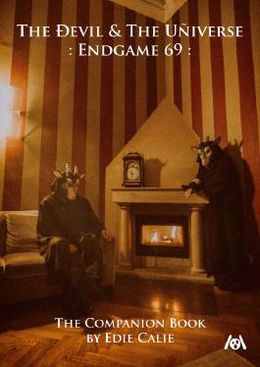
The two new videos, „Satanic (don’t) Panic“ and „Kali’s tongue“ by TDATU were recently released. Excellent execution of the theme! In the „The Companion Book“ you wrote for the new album „Endgame 69,“ alongside an entertaining story from the goat’s shared living with the unicorn, you also described the musical style. „Space disco“ and „Psychedelic Glam“ meet New Wave, Synth Pop, and Black Metal. In both videos, I especially find a psychedelic signature. Panic, drugs, societal upheavals, the Dream Machine. Was it difficult to visually implement this mood?
No, quite the opposite. Because there were concrete themes and visual cues with the entire ’69 theme, we had a lot to work with. It was clear that it would be visually more psychedelic, which I implemented in the editing. For „Satanic (don’t) Panic,“ I got to fully indulge in humor, portraying the goats as a hippie/Satanism protest band, which was especially fun for me. For Kali’s Tongue, we had Thomas Thalhammer, a great performer and creative mind on the team, who conveyed the Kali theme of the song superbly.
Many bands enjoy having their live concerts professionally filmed. For you as a video artist, which do you prefer? Live recordings or creating a video with the musicians/other performers for a song? What are the reasons for your preference?
Live concerts are a bit like paint-by-numbers for me. It’s relatively clear where the cameras should be and in editing, a few things are predetermined. When someone is singing, I want to see that person; when someone is playing a solo, I want to see the person playing it. Anything else gives me a very uneasy feeling in my stomach. Then there are camera angles that can’t be used right now because they are momentarily out of focus or there’s a pan or zoom that doesn’t fit at that moment. So, there aren’t as many options left in editing, because I’m not a fan of fast cuts where you can’t even see what’s happening because the next image is already being slapped in front of your eyes. I prefer music videos.
I mentioned earlier that you are also very productive as an author. In autumn 2019, just in time for the book fair, your latest work „Kein Eintritt für Erleuchtete“ will be released. Promising title, I suspect a lot of plot. Please tell us about it…
In „Kein Eintritt für Erleuchtete,“ a group of people tries to live their utopia of a discrimination-free alternative society where personal human development is central. Jakob, the 27-year-old protagonist, navigates through themes such as gender identity, feminism, sexual orientation, drugs, and depression to figure out how he actually wants to live, independent of upbringing and societal constraints. The story takes place in real existing locations in Vienna, to which I added a touch of fantasy, and it’s told from 53 different perspectives.
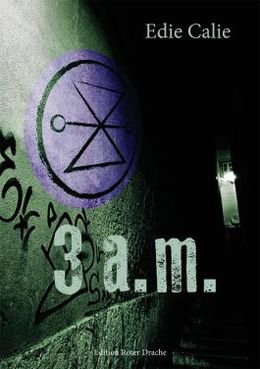
My personal reading recommendation is also your book „3 a.m.“ from 2013. An occult-ironic, postmodern novel. Is it comparable to your latest work? I immediately had ideas for a video for this novel… would that be an approach for you: visual promotion for one of your books? Or does that take away the readers‘ own imagination while reading?
„3 a.m.“ is a collection of colorful scraps of clothing flying through the air, of which readers can make sense only of some fabric pieces. „Kein Eintritt für Erleuchtete“ is a net in which readers can fall and be carried through the plot like a flying carpet. They share humor and underlying philosophy. One could say „3 a.m.“ is occult chaotic theory and „Kein Eintritt für Erleuchtete“ is the resulting practice, but actually, it’s just an entertaining story with unicorns, quirky characters, and near-death experiences. I see no reason to film it, not as a movie and certainly not for promotional purposes. I trust readers to have imaginations that are more colorful, more plastic, encompassing all senses, and therefore always more interesting than the video images offered to them.
Are you going on a book tour in 2019/2020?
I hope so. Nothing concrete is planned yet, but there will definitely be a reading in Vienna.
Thank you for your time! I look forward to future Edie Calie videos and your writings. I wish you many interested readers for your books.
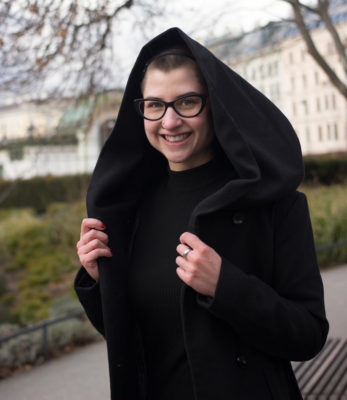
.
.
.
.
.
.


